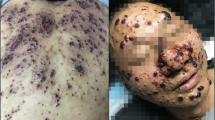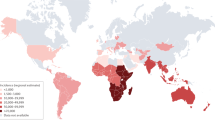Summary
The risk for AIDS patients from Cryptococcus neoformans is outlined on the basis of a case report on a 28-year old male patient whose disease was complicated by cryptococcosis.
Beside the description of the diagnosis of cryptococcosis (demonstration of the agent and its antigen), epidemiological associations (habitat of Cr. neoformans in fecal matter of birds) and the clinically, mostly not recognized, route of infection via the lungs is stressed.
The effective therapy with the combination of amphotericin B and 5-flucytosine, which also in this case has been successful is described from the clinical and microbiological angles.
Finally, proposals for the prevention of Cr. neoformans infections in AIDS patients and for a special mycological surveillance directed at this fungus are made.
Similar content being viewed by others
Abbreviations
- AIDS:
-
Autoimmundefektsyndrom
- BFE:
-
Braunfarbeffekt
- HTLV III:
-
Human-T-cell-Leukemia-Virus III
- ZNS:
-
Zentralnervensystem
Literatur
Ajello L (1980) Natural habitats of the fungi that cause pulmonary mycoses. In: Preusser H-J (ed) Medical Mycology. Zbl Bakt, Suppl 8, G Fischer, Stuttgart New York, pp 31–42
Bennett JE (1985) Cryptococcosis. Vortrag, 9. Kongress der International Society for Human and Animal Mycology, 19.–24.5.1985 in Atlanta/USA. Zbl Bakt Hyg, Abstracts (im Druck)
Bennett JE, Dismukes WE, Duma RJ, Medoff G, Sande MA, Gallis H, Leonhard J, Fields BT, Bradshaw M, Haywood H, McGee ZA, Cate TR, Cobbs CG, Warner JF, Alling DW (1979) A comparison of amphotericin B alone and combined with flucytosine in the treatment of cryptococcal meningitis. N Engl J Med 301:126–131
Breker H, Culmann H, Adler D, Cremer H, GroErworbenes Immundefektsyndromss R (1983) Erworbenes Immundefektsyndrom (AIDS). Dtsch Ärztebl, Ausg. B 80:26:33–38
Coester CH, Stüttgen G (1983) Homosexualität und sexuell übertragbare Erkrankungen einschließlich des erworbenen Immunmangelsyndroms. Internist 24:334–345
Curran JW (1985) (Center for Disease Control Atlanta/USA) Clinical, epidemiological and immunological aspects of AIDS. Vortrag, Berliner Medizinische Gesellschaft, 16.1.1985 in Berlin (West)
Diamond RD, Bennett JE (1974) Prognostic factors in cryptococcal meningitis. Ann Intern Med 80:176–181
Edwards VE (1970) Cryptococcosis of the central nervous system. Epidemiological, clinical and therapeutic features. J Neurol Neurosurg Psychiatr 33:415–420
Eng RHK, Buccini F, Smith SM (1985) The distribution and elimination of capsular polysaccharides of Cryptococcus neoformans in humans and animals. Poster, 9. Kongress der International Society for Human and Animal Mycology, 19.–24.5.1985 in Atlanta/USA. Zbl Bakt Hyg, Abstracts (im Druck)
Gopinathan S, Laubenstein L, Mondale B, Krigel RL (1983) Central nervous system manifestation of the acquired immunodeficiency syndrome in homosexual men. Neurology 33 Suppl 2:105–109
Grosse G, Staib F, Radlmeier E, Preuss W (1975) Cryptococcom and Amphotericin B. — Tierexperimentelle Untersuchungen zur Therapie der Cryptococcose. 2. Mitteilung: Patho-histologische Befunde. Zbl Bakt Hyg, I. Abt Orig A 230:518–533
Grosse G, Niedobitek F, l'Age M, Staib F (1981) Chronische Lungenkryptokokkose. — Ein kasuistischer Beitrag zur Diagnostik der Kryptokokkose des Menschen aus pathologisch-anatomischer Sicht. Dtsch med Wochenschr 106:1035–1037
Jäger H (1983) Das Acquired Immune Deficiency Syndrome. Dtsch Ärztebl, Ausg. B, 80:26:23–32
Kalden IR, Burmester GR, Manger B, Coester CH, Bienzle U (1983) Immunologische Befunde bei homosexuellen Männern mit generalisierter Lymphadenopathie. Prodromalstadium des “Acquired Immunodeficiency Syndrome”? Klin Wochenschr 61:1067–1073
Kaufman L, Blumer S (1977) Cryptococcosis. The awakening giant. Proc Fourth Internat Conference of the Mycoses, PAHO, Sci Publ No 356:176
Kozel TR, Reiss E, Cherniak R (1980) Concomitant but not causal association between surface charge and inhibition of phagocytosis by cryptococcal polysaccharide. Infect Immun 29:295–300
Kwon-Chung KJ (1985) Persönliche Mitteilung
Levine AS (1982) The epidemic of acquired immune dysfunction in homosexual men and its sequelal — opportunistic infections, — Kaposi's sarcoma and other malignancies: An update and interpretation. Cancer Treat Rep 66:1391–1395
Mishra SK, Staib F, Folkens U, Fromlting RA (1981) Serotypes of Cryptococcus neoformans strains isolated in Germany. J Clin Microbiol 14:106–107
Ostendorf P, Link H (1983) Pharmakologie, Pharmakokinetik und Toxizität von Amphotericin B. In: Meinhof W, Seeliger H, Wegmann T und Schönfeld H (Hrsg) Systemische Mykosen. Hahnenklee-Symposium. Editions Roche Basel-Grenzach-Wyhlen, S 151–168
Pulst STM (1984) Neurologische Komplikationen bei erworbenem Immundefektsyndrom (AIDS). Nervenarzt 55:407–412
Rabe W, Reimer F (1971) Meningoencephalitis durch Cryptococcus neoformans. Dtsch med Wochenschr 96:1163–1165
Salfelder K (1971) Cryptococcosis. In: Handbuch der speziellen pathologischen Anatomie und Histologie. Infektionen des Menschen durch Pilze, Aktinomyzeten und Algen. Bd III/5 Hrsg Baker RD, Springer, Berlin, pp 383–464
Seeliger HRP, Heymer Th (1981) Diagnostik pathogener Pilze des Menschen und seiner Umwelt. Thieme, Stuttgart New York
Siegal FP, Lopez C, Hammer GS, Brown AE, Kornfeld SJ, Gold J, Hassett J, Hirschmann SL, Cunningham-Rundless S, Adelsberg BR, Parham DM, Siegal M, Cunningham-Rundles S, Armstrong D (1981) Severe acquired immunodeficiency in male homosexuals, manifested by chronic perianal herpes simplex lesions. New Engl J Med 305:1439
Siegenthaler W (1985) Sexuell übertragbare Infektionen: Aktuell ist nicht nur AIDS. Moku ärztl Fortb 35:3:14–16
Snider WD, Simpson DM, Nielsen S, Gold JW, Metroka CE, Posner JB (1983) Neurological complications of acquired immune deficiency syndrome: Analysis of 50 patients. Ann Neurol 14:403–418
Staib F (1981) Pilzinfektionen des Zentralnervensystems. In: Hopf HCH, Poeck K, Schliack H (Hrsg): Neurologie in Praxis und Klinik, Bd II. Thieme, Stuttgart, S 4.163–4.170
Staib F (1982) Mykotische Meningoencephalitiden. Bundesgesundheitsbl 25:305–314
Staib F (1984) Airborne dissemination of Cryptococcus neoformans from bird manure. In: Berglund B, Lindvall T, Sundell T (eds) Indoor Air, Vol 3, Swedish Council for Building Research, Stockholm, pp 271–276
Staib F (1984) Pilze als Krankheitserreger und ihre aktuelle Bedeutung. Kassenarzt 23:39:49–54
Staib F (1985) Sampling and isolation of Cryptococcus neoformans from indoor air with the aid of the Reuter Centrifugal Sampler (RCS) and Guizotia abyssinica creatinine agar. — A contribution to the mycological-epidemiological control of Cr. neoformans in the fecal matter of caged birds. Zbl Bakt Hyg, I. Abt Orig B 180:567–575
Staib F (1985) Vorschläge zur Bekämpfung aerogener tiefer Mykosen bei immungeschwächten Personen. Bundesgesundheitsbl 28:132–138
Staib F (1985) Zur Diagnostik von Lungenmykosen. Atemw.-Lungenkrkh 11:3–5
Staib F, Mishra SK, Grosse G, Abel Th (1977) Pathogenesis and therapy of cryptococcosis in animal experiments. Contr Microbiol Immunol 3:48–59 (Karger, Basel)
Staib F, Schulz-Dieterich J (1984) Cryptococcus neoformans in fecal matter of birds kept in cages. — Control of Cr. neoformans habitats. Zbl Bakt Hyg, I. Abt Orig B 179:179–186
Thomsen RB, Roberts GD (1982) A practical approach to the diagnosis of fungal infections of the respiratory tract. Clin Lab Med 2:321–342
U.S. Department of Health and Human Services/Public Health Service (1981) Kaposi's Sarcoma and pneumocystis pneumonia among homosexual men — New York City and California. MMWR 30:305–308
Utz JP, Butler WT (1965) Cryptococcus-Meningitis. — Neuere Beobachtungen zur Erkennung und Therapie. Dtsch med Wochenschr 90:941–943
Vogt M, Füthy R, Siegenthaler W (1982) GRID-Syndrom. Dtsch med Wochenschr 107:1539–1542
Wegener HH, Staib F (1983) Tödliche Cryptococcose eines Vogelliebhabers. — Ein kasuistischer Beitrag zur Pathologie, Diagnostik und Epidemiologie der Cryptococcose. Zbl Bakt Hyg, A 256:231–236
Wegmann T (1982) Therapie der Aspergillusmykose. Fa. Hoffmann-La Roche AG, Grenzach-Wyhlen
Wegmann T (1984) Antimykotische Chemotherapie bei Resistenzschwäche. Immun Infekt 12:181–185
Wiebecke B, Staib F (1965) Generalisierte Kryptokokkose. Münch med Wochenschr 107:361–365
Author information
Authors and Affiliations
Rights and permissions
About this article
Cite this article
Bohle, C., Sinn, M., Werner, E. et al. Cryptococcus neoformans-Meningoencephalitis bei AIDS. Klin Wochenschr 64, 165–172 (1986). https://doi.org/10.1007/BF01713457
Received:
Revised:
Accepted:
Issue Date:
DOI: https://doi.org/10.1007/BF01713457




